>
> |
| META TOPICPARENT |
name="SubmitCaseStudy" |
<--
This template controls both the look and functionality of case study topics.
You should not need to alter the layout, only edit the data using the form above.
Set the view and edit templates:
Comment out the next line to use the TWiki default view
Comment out the next line to use the TWiki default edit
-->
<--
This topic can only be changed by:
-->
Case Study: Extended Health Clinic
Submitted: 25 Sep 2017
Application Areas: Healthcare
Contents
Problem Description
This case study extends the Simple Health Clinic – Scheduled Appointments model. The extensions are:
- Walk-up patients are triaged before receiving treatment;
- After being triaged, some walk-up patients need to have a test performed before seeing a doctor;
- Appointment patients arrive at their appointment times +/- a few minutes;
- The arrival rate of walk-up patients varies over the day.
The goal of this simulation study is to analyse the average time patients spend:
- waiting for treatment; and
- in the clinic;
and the average length of the patient queue (which informs waiting room size). This analysis will include a comparison of the walk-up vs scheduled patients.
Return to top
Problem Formulation
In order to formulate a simulation model we specify the following components:
- Background – problem description
- Objectives of the study
- Expected benefits
- The CM: inputs, outputs, content, assumptions, simplifications’
- Experiments to run
Components 1(Background – problem description) and 2 (Objectives of the study) are given in the Problem Description section (see paragraph describing the goal of the simulation study to identify study objectives).
The Expected benefits (component 3) are a virtual environment for evaluating patient waiting times, total time patients spend in the clinic, and the number of patients waiting for treatment. This environment can be used to experiment with changes to the clinic, including a comparison of effects on the waiting times, queue length, etc for the walk-up vs the scheduled patients.
The CM content is specified using the following components:
- Component List
- Process flow diagram
- Logic flow diagram
- Activity cycle diagram
Component List
The components of the Extended Health Clinic model are:
- Walk-up patients with their (inter)arrival times
- Scheduled patients with their appointment times
- Triage nurses with their triage times
- Test nurses with their testing times
- Doctors with their treatment times
- Waiting room with its capacity
Process Flow Diagram
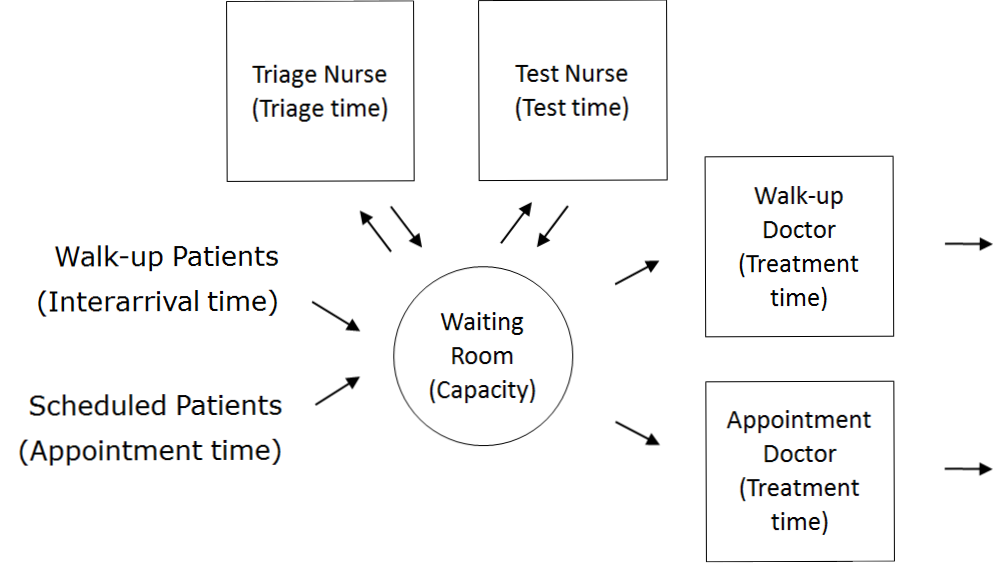
| Patient Logic Flow Diagram | | Doctor Logic Flow Diagrams |
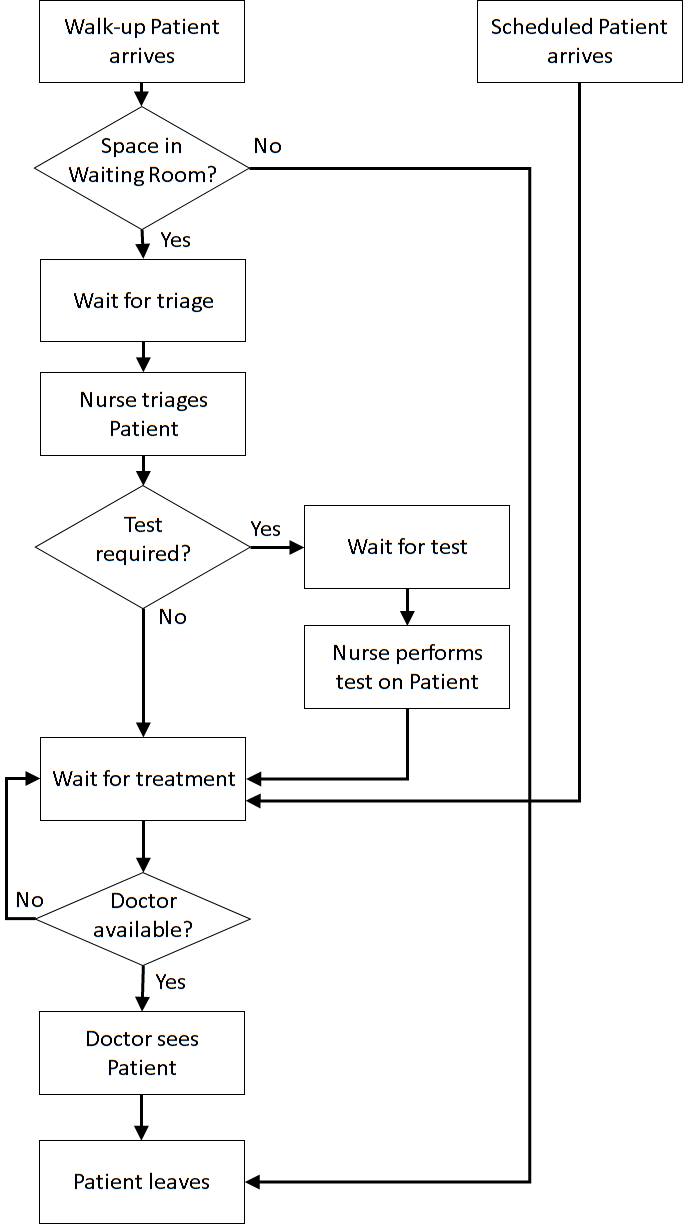 | | 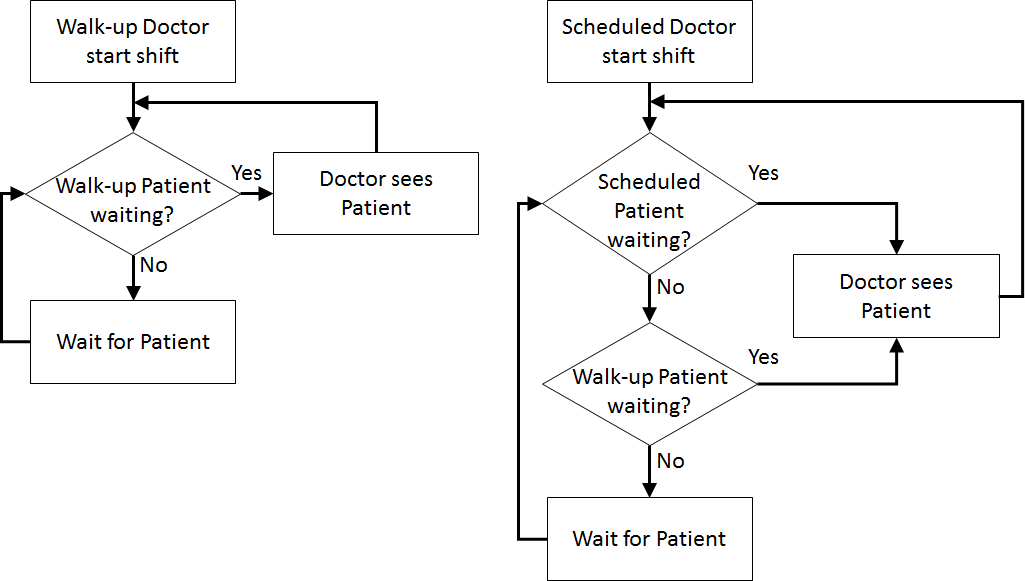 |
| Nurse Logic Flow Diagrams |
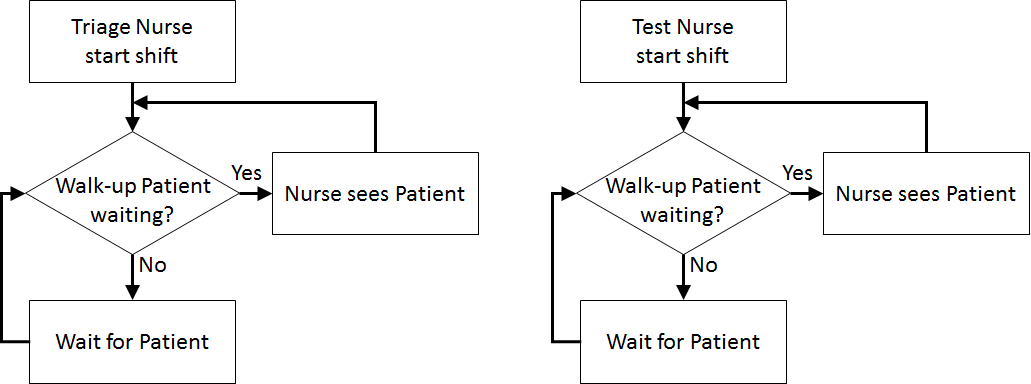 |
Activity Cycle Diagram
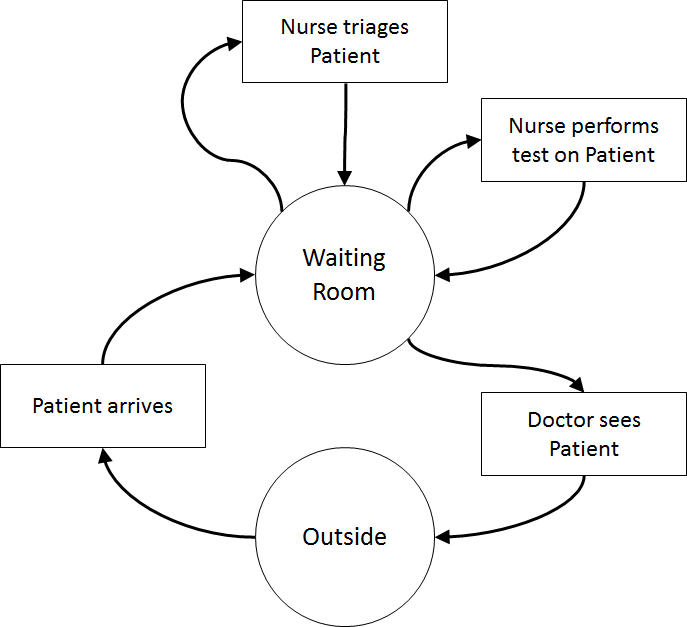 Once the content has been established (note this is usually an iterative process) we can identify the inputs and outputs: appointment times, interarrival times, triage times, test times, treatment times, waiting times for triage, testing, and treatment (i.e., Patient arrives to Nurse triages Patient, Nurse triages Patient to Nurse performs test on Patient, Nurse performs test on Patient to Doctor sees Patient, Nurse triages Patient to Doctor sees Patient, Patient arrives to Doctor sees Patient), total clinic time (Patient arrives to Outside), number in waiting room.
Assumptions are used to define stochasticity (e.g., Exponential interarrivals, Triangular treatment times) and the simplifications keep the system simple (e.g., single doctors and nurses on all day for triage, testing, and treatment, no registration, no prioritisation).
Return to top
Once the content has been established (note this is usually an iterative process) we can identify the inputs and outputs: appointment times, interarrival times, triage times, test times, treatment times, waiting times for triage, testing, and treatment (i.e., Patient arrives to Nurse triages Patient, Nurse triages Patient to Nurse performs test on Patient, Nurse performs test on Patient to Doctor sees Patient, Nurse triages Patient to Doctor sees Patient, Patient arrives to Doctor sees Patient), total clinic time (Patient arrives to Outside), number in waiting room.
Assumptions are used to define stochasticity (e.g., Exponential interarrivals, Triangular treatment times) and the simplifications keep the system simple (e.g., single doctors and nurses on all day for triage, testing, and treatment, no registration, no prioritisation).
Return to top
Computational Model
Start with the Simple Health Clinic – Scheduled Appointments JaamSim model.
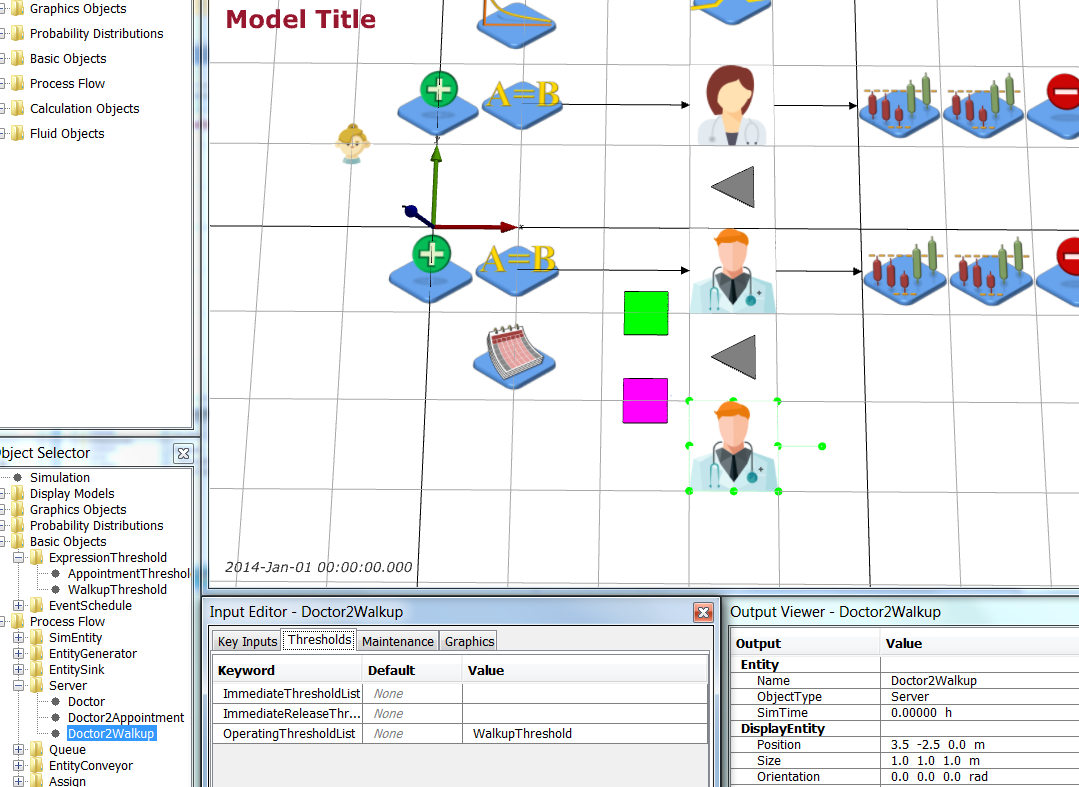 Select the PatientEntity and add a Test attribute to the AttributeDefinitionList by adding { Test 0} to the list.
Select the PatientEntity and add a Test attribute to the AttributeDefinitionList by adding { Test 0} to the list.
 Now add a distribution that determines if a Walk-Up patient needs a test or not. Add a DiscreteDistribution object from Model Palette > Probability Distributions. Name it TestDistribution and edit it so that 30% of Walk-Up patients require tests.
Now add a distribution that determines if a Walk-Up patient needs a test or not. Add a DiscreteDistribution object from Model Palette > Probability Distributions. Name it TestDistribution and edit it so that 30% of Walk-Up patients require tests.
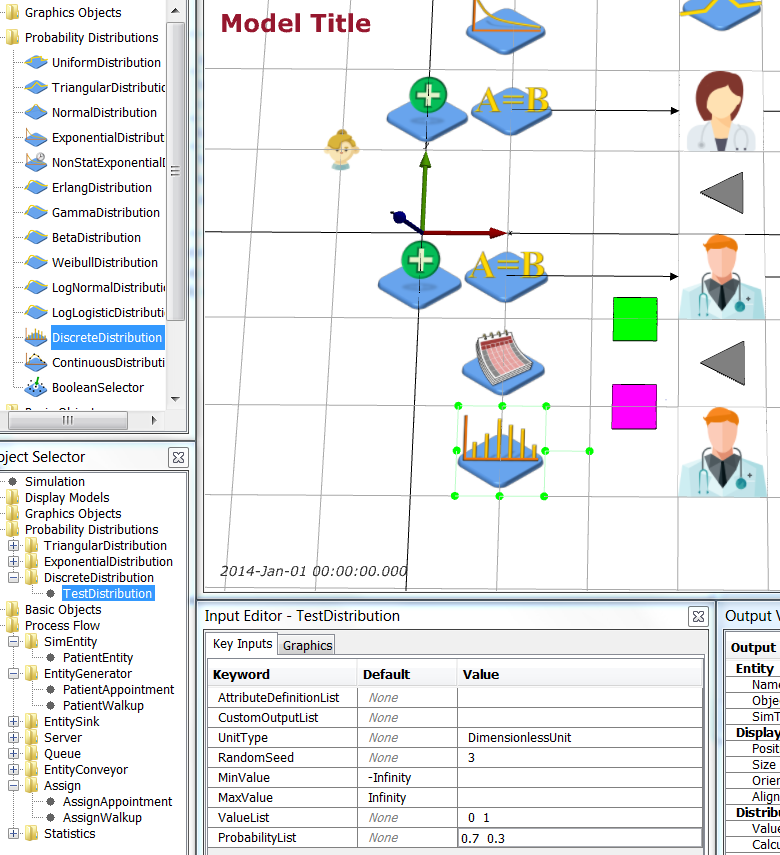
| Object |
Graphics |
Key Inputs |
| TestDistribution |
Position = 1 -2.5 0.0 m |
UnitType = DimensionlessUnit, RandomSeed = 3, ValueList = 0 1, ProbabilityList = 0.7 0.3 |
Now select the AssignWalkup object and add { 'this.obj.Test = [TestDistribution].Value' } to AttributeAssignmentList.
 Save your simulation.
Next, create two new servers (Process Flow > Server), one for triage and one for testing. Name then NurseTriage and NurseTest respectively and give them the nurse.png (icon made by Freepik from www.flaticon.com
Save your simulation.
Next, create two new servers (Process Flow > Server), one for triage and one for testing. Name then NurseTriage and NurseTest respectively and give them the nurse.png (icon made by Freepik from www.flaticon.com ) graphic. Lay out NurseTriage (on the left), NurseTest (on the right), and TestDistribution (near NurseTest) as shown below: ) graphic. Lay out NurseTriage (on the left), NurseTest (on the right), and TestDistribution (near NurseTest) as shown below:
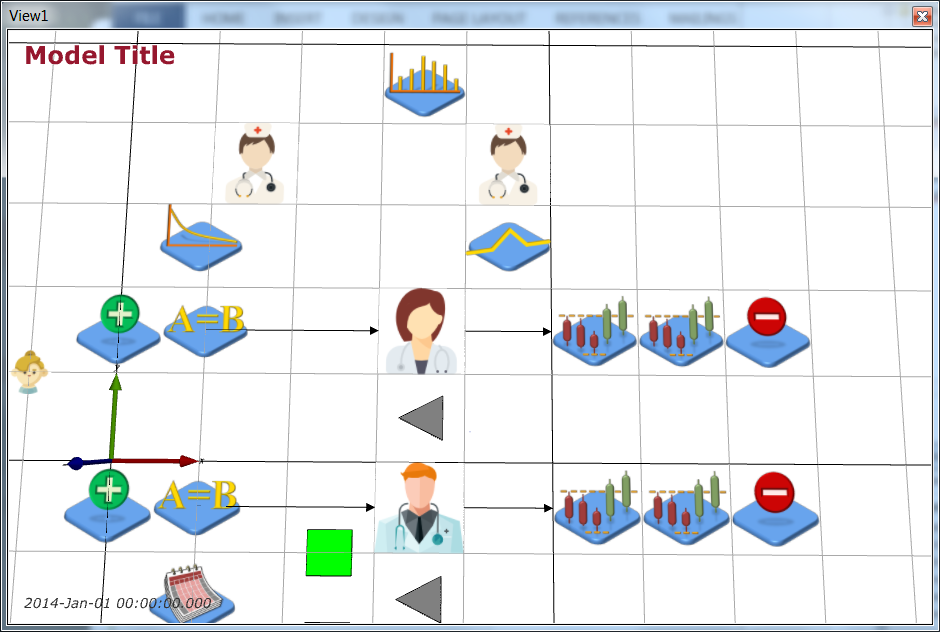 Rename the ArriveToTreat EntityConveyor to be ArriveToTriage and change NextComponent to be NurseTriage. You can redirect the EntityConveyor by clicking on it, then Ctrl-clicking on its end point and dragging it to where you want it to be. Redirect ArriveToTriage as shown below:
Rename the ArriveToTreat EntityConveyor to be ArriveToTriage and change NextComponent to be NurseTriage. You can redirect the EntityConveyor by clicking on it, then Ctrl-clicking on its end point and dragging it to where you want it to be. Redirect ArriveToTriage as shown below:
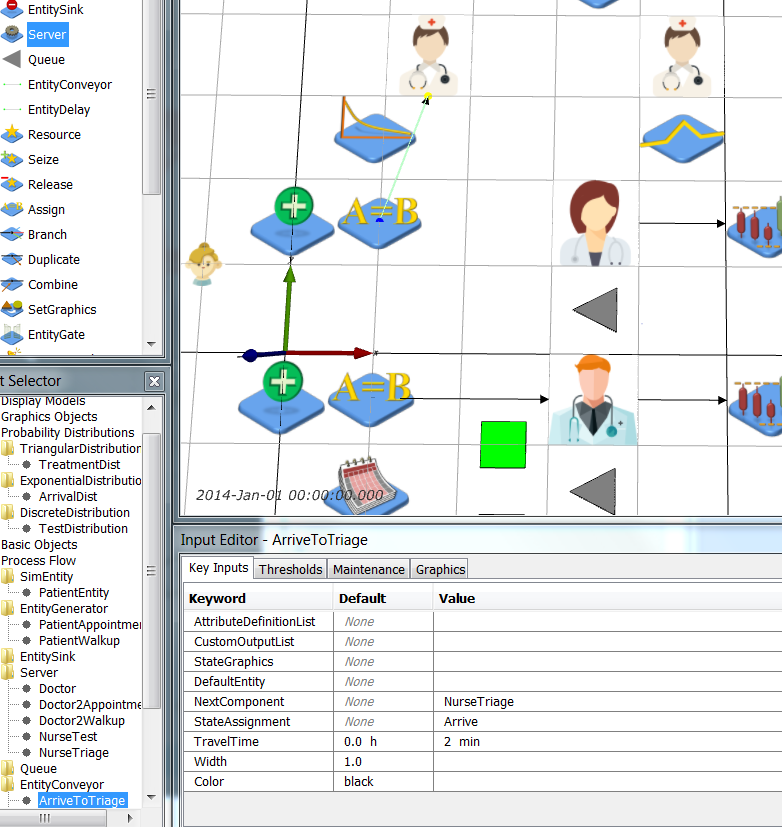 Next, we need to add the branching for the potential test. Add a Branch object (Model Palette > Process Flow > Branch) and name it TestBranch. Now add 3 more EntityConveyors: TriageToDoctor, TriageToTest, TestToDoctor. TestBranch and the 3 conveyors are shown below (TriageToTest going horizontal left to right, TriageToDoctor diagonally down left, TestToDoctor diagonally down left).
Next, we need to add the branching for the potential test. Add a Branch object (Model Palette > Process Flow > Branch) and name it TestBranch. Now add 3 more EntityConveyors: TriageToDoctor, TriageToTest, TestToDoctor. TestBranch and the 3 conveyors are shown below (TriageToTest going horizontal left to right, TriageToDoctor diagonally down left, TestToDoctor diagonally down left).
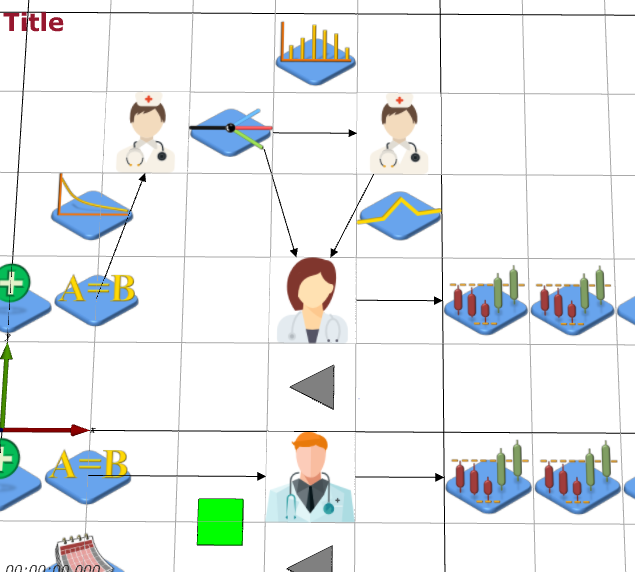 Next, make sure that the flow of the patients through the triage and test conveyors and servers is set correctly. The TestBranch object uses the value of the entities' Test attribute with 1 added to it to transform it from a {0, 1} value to a {1, 2} value (JaamSim starts lists at 1 not 0), so a patient that doesn't need a test (Test = 0) goes to the first component in the list, i.e., TriageToDoctor conveyor.
Next, make sure that the flow of the patients through the triage and test conveyors and servers is set correctly. The TestBranch object uses the value of the entities' Test attribute with 1 added to it to transform it from a {0, 1} value to a {1, 2} value (JaamSim starts lists at 1 not 0), so a patient that doesn't need a test (Test = 0) goes to the first component in the list, i.e., TriageToDoctor conveyor.
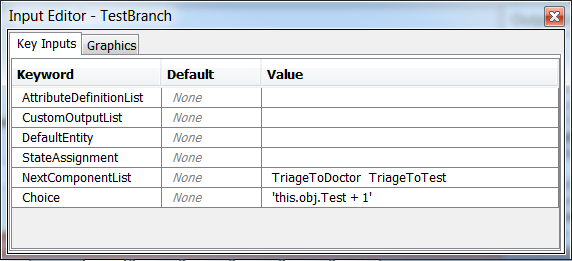
| Object |
Key Inputs |
| ArriveToTriage |
NextComponent = NurseTriage |
| NurseTriage |
NextComponent = TestBranch |
| TestBranch |
NextComponentList = TriageToDoctor TriageToTest, Choice = 'this.obj.Test + 1' |
| TriageToDoctor |
NextComponent = Doctor, TravelTime = 2 min |
| TriageToTest |
NextComponent = NurseTest, TravelTime = 2 min |
| NurseTest |
NextComponent = TestToDoctor |
| TestToDoctor |
NextComponent = Doctor, TravelTime = 2 min |
Save your simulation.
Now, add Queues for both triage and testing, set these queues as the wait queues for triage and testing. The treatment time is modelled by a triangular distribution with minimum 2 minutes, maximum 15 minutes and mode (most likely) 8 minutes, so add a TriangularDistribution called TriageDistribution with these parameters. The test time is modelled as a constant time of 10 minutes, so add this to the NurseTest's ServiceTime. You need to change the StateAssignment of NurseTriage and NurseTest to reflect these activities too.
| Object |
Key Inputs |
| NurseTriage |
WaitQueue = TriageQueue, StateAssignment = Triage, ServiceTime = TriageDistribution |
| NurseTest |
WaitQueue = TestQueue, StateAssignment = Test, ServiceTime = 10 min |
| TriageDistribution |
UnitType = TimeUnit, RandomSeed = 4, MinValue = 2 min, MaxValue = 15 min, Mode = 8 min |
Finally, you should change the StateAssignment of all your queues so that we can track the time spent waiting for various sets in the pathway. You also need to change the DefaultStateList of your patient entities.
| Object |
Key Inputs |
| WalkupQueue |
StateAssignment = WaitTreat |
| AppointmentQueue |
StateAssignment = WaitTreat |
| TriageQueue |
StateAssignment = WaitTriage |
| TestQueue |
StateAssignment = WaitTest |
| PatientEntity |
DefaultStateList = { Arrive WaitTreat WaitTriage WaitTest Treat Triage Test Leave } |
Save your simulation.
At this point you can run your simulation and ensure that your triage/test process does not cause any errors.
However, now that the PatientEntity has new states we need to modify and append our Statistics modules and Simulation output. Change the existing Statistics modules to gather all the time in the system and waiting times and change the outputs generated by the simulation.
| Object |
Key Inputs |
| TimeInSystem |
SampleValue = 'this.obj.StateTimes("Arrive") + this.obj.StateTimes("WaitTriage") + this.obj.StateTimes("Triage") + this.obj.StateTimes("WaitTest") + this.obj.StateTimes("Test") + this.obj.StateTimes("WaitTreat") + this.obj.StateTimes("Treat") + this.obj.StateTimes("Leave")' |
| WaitingTime |
NextComponent = WaitingTriage
SampleValue = 'this.obj.StateTimes("WaitTriage") + this.obj.StateTimes("WaitTest") + this.obj.StateTimes("WaitTreat")' |
| TimeInSystem2 |
SampleValue = 'this.obj.StateTimes("Arrive") + this.obj.StateTimes("WaitTreat") + this.obj.StateTimes("Treat") + this.obj.StateTimes("Leave")' |
| WaitingTime2 |
SampleValue = this.obj.StateTimes("WaitTreat") |
| WaitingTriage (New Statistics component) |
UnitType = TimeUnit
NextComponent = WaitingTest
SampleValue = this.obj.StateTimes("WaitTriage") |
| WaitingTest (New Statistics component) |
UnitType = TimeUnit
NextComponent = WaitingTreat
SampleValue = this.obj.StateTimes("WaitTest") |
| WaitingTreat (New Statistics component) |
UnitType = TimeUnit
NextComponent = PatientWalkupSink
SampleValue = this.obj.StateTimes("WaitTreat") |
| Simulation |
UnitTypeList = DimensionlessUnit TimeUnit TimeUnit TimeUnit TimeUnit TimeUnit DimensionlessUnit DimensionlessUnit TimeUnit TimeUnit DimensionlessUnit DimensionlessUnit
RunOutputList = { [Simulation].RunIndex(1) } { [WaitingTriage].SampleAverage } { [WaitingTest].SampleAverage } { [WaitingTreat].SampleAverage } { [WaitingTime].SampleAverage } { [TimeInSystem].SampleAverage } { '[TriageQueue].QueueLengthAverage + [TestQueue].QueueLengthAverage + [WalkupQueue].QueueLengthAverage' } { [Doctor].Utilisation } { [WaitingTime2].SampleAverage } { [TimeInSystem2].SampleAverage } { [AppointmentQueue].QueueLengthAverage } { '[Doctor2Appointment].Utilisation + [Doctor2Walkup].Utilisation' } |
Save your simulation.
Run your simulation and use Lab3Analysis.R to look at the results from your simulation with the triage and tests added. The confidence intervals results should look as follows:
By contrast, the final results from SHC with Scheduled Appointments are:
Hence, the walk-up patients are worse off because of the extras steps in their pathways, but the appointment patients are a little better off with the triage and testing process in place. This make sense as the flow of walk-up patients to the doctors has been "stretched" by the triage and testing process, so less walk-up patients will be able to take advantage of any gaps in the appointment schedule and less appointment patients will get delayed by walk-up patients utilising the doctor for appointment patients.
Next, we add some uncertainty to the arrival time of appointment patients by adding a little "noise" to their arrival. Create a NormalDistribution object called AppointmentDistribution with mean 0 minutes, standard deviation 5 minutes and minimum value -15 minutes (this will "truncate" the negative tail of the distribution. Add the value from this distribution to the AppointmentTimes value in the PatientAppointment EntityGenerator.
| Object |
Key Inputs |
| AppointmentDistribution |
UnitType = TimeUnit
RandomSeed = 5
MinValue = -15 min
Mean = 0 min
StandardDeviation = 5 min |
| PatientAppointment |
FirstArrivalTime = '[AppointmentTimes].Value + [AppointmentDistribution].Value'
InterArrivalTime = '[AppointmentTimes].Value + [AppointmentDistribution].Value' |
Save your simulation.
Re-run your simulation and see what effect the appointment time "noise" has. Here is the doctor utilisation and appointment patients' statistics:
Finally, we add some non-stationarity to the arrival rate of the walk-up patients. Add a TimeSeries object call WalkupRates to define the changing arrival rates of walk-up patients. Suppose we want an arrival process with exponentially distributed interarrival times with mean 1 hour between midnight and 8 a.m. (8 arrivals expected), mean 15 mins between 8 a.m. and 5 p.m. (36 arrivals expected), and mean 30 mins between 5 p.m. and midnight (14 arrivals expected). We would edit WalkupRates to define the number that arrived over time as follows:
| Object |
Key Inputs |
| WalkupRates |
UnitType = DimensionlessUnit
Value = {0 h 0} {8 h 8} {17 h 44} {24 h 58}
CycleTime = 24 h |
This means that at 0 hrs, 0 have arrived, at 8 hrs 8 have arrived, at 17 hrs 44 (8 + 36) have arrived, and at 24 hrs 58 ( 8 + 36 + 14) have arrived.
Add a NonStatExponentialDistribution called WalkupDistribution to your model that uses WalkupRates to generate arrivals:
Lastly, use WalkupDistribution to define the first and inter arrivals times in the PatientWalkup EntityGenerator.
| Object |
Key Inputs |
| PatientWalkup |
FirstArrivalTime = '([Simulation].RunIndex(1) == 1) || ([Simulation].RunIndex(1) == 3) ? 20[min] : [WalkupDistribution].Value'
InterArrivalTime = '([Simulation].RunIndex(1) == 1) || ([Simulation].RunIndex(1) == 3) ? 20[min] : [WalkupDistribution].Value' |
Save your simulation.
Return to top
Results
As in SHC with Scheduled Appointments, perform 100 runs of this simulation each 168 hours long and with 24 hours warm up to examine the effect of the changes to the health clinic and observe the difference in average time in system and queue length for the walk up and appointment patients, and the difference in utilisation of the walk up only doctor and the appointment and walk up doctor. No changes to the Simulation object’s Key Inputs other than those described earlier in this case study are needed. The Simulation runs are as follows:
Run your simulation and modify Lab3Analysis.R to use your new .dat file. Your results should be as below.
WalkUp.WaitingTriage WalkUp.WaitingTest WalkUp.WaitingTreat
ConfLower 0.06360199 0.001792959 0.1694404
Mean 0.06682758 0.001953419 0.1824697
ConfUpper 0.07005316 0.002113880 0.1954990
WalkUp.WaitingTime WalkUp.TimeInSystem Num.WalkUps.Waiting
ConfLower 0.2362326 0.7518122 0.5720433
Mean 0.2512507 0.7671848 0.6122041
ConfUpper 0.2662688 0.7825573 0.6523649
Doctor.Utilisation Appointment.WaitingTime Appointment.TimeInSystem
ConfLower 0.4941766 0.1261258 0.4090825
Mean 0.4993517 0.1292271 0.4126293
ConfUpper 0.5045268 0.1323284 0.4161760
Appointment.Queue Doctor2.Utilisation
ConfLower 0.3721434 0.8395105
Mean 0.3817525 0.8425352
ConfUpper 0.3913617 0.8455598
> t.test(Lab3scen$WalkUp.WaitingTime, Lab3scen$Appointment.WaitingTime)
Welch Two Sample t-test
data: Lab3scen$WalkUp.WaitingTime and Lab3scen$Appointment.WaitingTime
t = 15.789, df = 107.43, p-value < 2.2e-16
alternative hypothesis: true difference in means is not equal to 0
95 percent confidence interval:
0.1067035 0.1373437
sample estimates:
mean of x mean of y
0.2512507 0.1292271
|
> t.test(Lab3scen$WalkUp.TimeInSystem, Lab3scen$Appointment.TimeInSystem)
Welch Two Sample t-test
data: Lab3scen$WalkUp.TimeInSystem and Lab3scen$Appointment.TimeInSystem
t = 44.593, df = 110.3, p-value < 2.2e-16
alternative hypothesis: true difference in means is not equal to 0
95 percent confidence interval:
0.3387978 0.3703132
sample estimates:
mean of x mean of y
0.7671848 0.4126293
|
> t.test(Lab3scen$Num.WalkUps.Waiting, Lab3scen$Appointment.Queue)
Welch Two Sample t-test
data: Lab3scen$Num.WalkUps.Waiting and Lab3scen$Appointment.Queue
t = 11.073, df = 110.3, p-value < 2.2e-16
alternative hypothesis: true difference in means is not equal to 0
95 percent confidence interval:
0.1892095 0.2716937
sample estimates:
mean of x mean of y
0.6122041 0.3817525
|
> t.test(Lab3scen$Doctor.Utilisation, Lab3scen$Doctor2.Utilisation)
Welch Two Sample t-test
data: Lab3scen$Doctor.Utilisation and Lab3scen$Doctor2.Utilisation
t = -113.6, df = 159.57, p-value < 2.2e-16
alternative hypothesis: true difference in means is not equal to 0
95 percent confidence interval:
-0.3491496 -0.3372173
sample estimates:
mean of x mean of y
0.4993517 0.8425352
|
What do these results tell you?
We will also add an ExpressionLogger to watch the total number of patients in the waiting room (assuming all waiting patients are in the waiting room). Go to Model Builder > Basic Objects > ExpressionLogger and add an ExpressionLogger called WaitingRoom. It will only look at the total of the queues and also log whenever that total changes. Thus we only need to edit the Tracing tab:
| Object |
Tracing |
| WaitingRoom |
ValueUnitTypeList = DimensionlessUnit
ValueTraceList = { '[TriageQueue].QueueLength + [TestQueue].QueueLength + [WalkupQueue].QueueLength + [AppointmentQueue].QueueLength' } |
Now adapt parse_multiple_runs_log.R to draw the number in the waiting room for the first 10 replications (note that parse_single_run_log.R is also attached for your reference). The plot should look like:
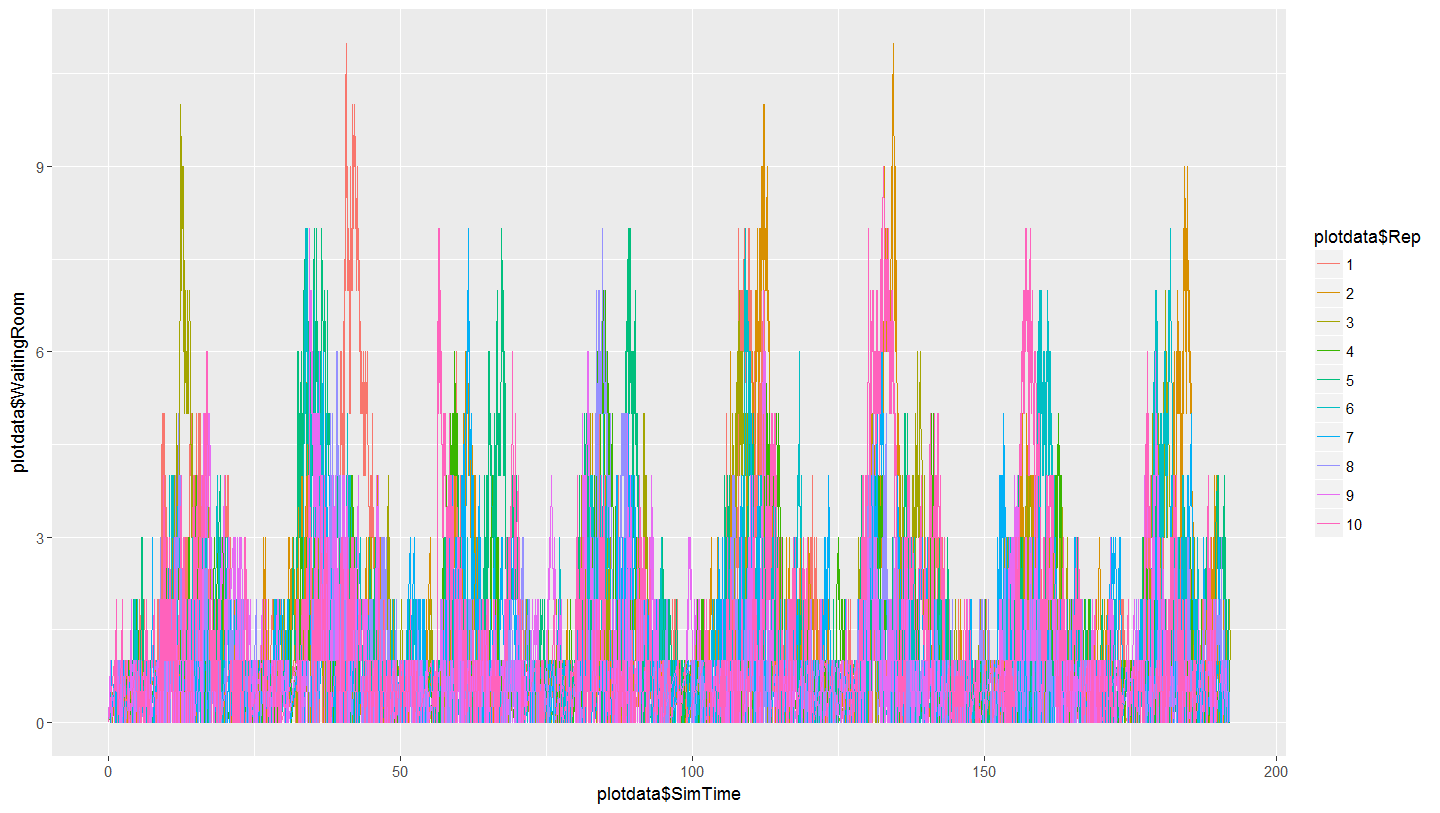 Note the cyclical nature of the plot that demonstrates the daily effect of the variable arrival rates for walk-up patients.
Return to top
Note the cyclical nature of the plot that demonstrates the daily effect of the variable arrival rates for walk-up patients.
Return to top
Conclusions
In this case study, you extended the SHC with Scheduled Appointments models to a triage/testing process, "noise" on appointment patient arrivals, and non-stationary arrival rates for walk-up patients. You investigated the effect of the changes as well as plotting the number in the waiting room over time to see the effect of non-stationarity.
Given the imbalance between the utilisation of the doctors, how should the two doctors be rostered to ensure their workload is equitable?
Return to top
<--
-->
<--
-->
|*FORM FIELD ProblemDescription*|ProblemDescription|This case study extends the Simple Health Clinic – Scheduled Appointments model. The extensions are:
- Walk-up patients are triaged before receiving treatment;
- After being triaged, some walk-up patients need to have a test performed before seeing a doctor;
- Appointment patients arrive at their appointment times +/- a few minutes;
- The arrival rate of walk-up patients varies over the day.
The goal of this simulation study is to analyse the average time patients spend:
- waiting for treatment; and
- in the clinic;
and the average length of the patient queue (which informs waiting room size). This analysis will include a comparison of the walk-up vs scheduled patients.
|
|*FORM FIELD ProblemFormulation*|ProblemFormulation|In order to formulate a simulation model we specify the following components:
- Background – problem description
- Objectives of the study
- Expected benefits
- The CM: inputs, outputs, content, assumptions, simplifications’
- Experiments to run
Components 1(Background – problem description) and 2 (Objectives of the study) are given in the Problem Description section (see paragraph describing the goal of the simulation study to identify study objectives).
The Expected benefits (component 3) are a virtual environment for evaluating patient waiting times, total time patients spend in the clinic, and the number of patients waiting for treatment. This environment can be used to experiment with changes to the clinic, including a comparison of effects on the waiting times, queue length, etc for the walk-up vs the scheduled patients.
The CM content is specified using the following components:
- Component List
- Process flow diagram
- Logic flow diagram
- Activity cycle diagram
Component List
The components of the Extended Health Clinic model are:
- Walk-up patients with their (inter)arrival times
- Scheduled patients with their appointment times
- Triage nurses with their triage times
- Test nurses with their testing times
- Doctors with their treatment times
- Waiting room with its capacity
Process Flow Diagram

| Patient Logic Flow Diagram | | Doctor Logic Flow Diagrams |
 | |  |
| Nurse Logic Flow Diagrams |
 |
Activity Cycle Diagram
 Once the content has been established (note this is usually an iterative process) we can identify the inputs and outputs: appointment times, interarrival times, triage times, test times, treatment times, waiting times for triage, testing, and treatment (i.e., Patient arrives to Nurse triages Patient, Nurse triages Patient to Nurse performs test on Patient, Nurse performs test on Patient to Doctor sees Patient, Nurse triages Patient to Doctor sees Patient, Patient arrives to Doctor sees Patient), total clinic time (Patient arrives to Outside), number in waiting room.
Assumptions are used to define stochasticity (e.g., Exponential interarrivals, Triangular treatment times) and the simplifications keep the system simple (e.g., single doctors and nurses on all day for triage, testing, and treatment, no registration, no prioritisation).
|
|*FORM FIELD ComputationalModel*|ComputationalModel|Start with the Simple Health Clinic – Scheduled Appointments JaamSim model.
Once the content has been established (note this is usually an iterative process) we can identify the inputs and outputs: appointment times, interarrival times, triage times, test times, treatment times, waiting times for triage, testing, and treatment (i.e., Patient arrives to Nurse triages Patient, Nurse triages Patient to Nurse performs test on Patient, Nurse performs test on Patient to Doctor sees Patient, Nurse triages Patient to Doctor sees Patient, Patient arrives to Doctor sees Patient), total clinic time (Patient arrives to Outside), number in waiting room.
Assumptions are used to define stochasticity (e.g., Exponential interarrivals, Triangular treatment times) and the simplifications keep the system simple (e.g., single doctors and nurses on all day for triage, testing, and treatment, no registration, no prioritisation).
|
|*FORM FIELD ComputationalModel*|ComputationalModel|Start with the Simple Health Clinic – Scheduled Appointments JaamSim model.
 | |
| FORM FIELD Results |
Results |
The results... |
| FORM FIELD Conclusions |
Conclusions |
In conclusion... |
| FORM FIELD ExtraForExperts |
ExtraForExperts |
| FORM FIELD StudentTasks |
StudentTasks |
| META FILEATTACHMENT |
attachment="ActivityCycleDiagram.png" attr="h" comment="" date="1506305881" name="ActivityCycleDiagram.png" path="ActivityCycleDiagram.png" size="15772" stream="ActivityCycleDiagram.png" tmpFilename="/var/tmp/CGItemp12521" user="MichaelOSullivan" version="1" |
| META FILEATTACHMENT |
attachment="DoctorLogicFlowDiagram.png" attr="h" comment="" date="1506305891" name="DoctorLogicFlowDiagram.png" path="DoctorLogicFlowDiagram.png" size="16399" stream="DoctorLogicFlowDiagram.png" tmpFilename="/var/tmp/CGItemp12545" user="MichaelOSullivan" version="1" |
| META FILEATTACHMENT |
attachment="NurseLogicFlowDiagram.png" attr="h" comment="" date="1506305905" name="NurseLogicFlowDiagram.png" path="NurseLogicFlowDiagram.png" size="9216" stream="NurseLogicFlowDiagram.png" tmpFilename="/var/tmp/CGItemp12528" user="MichaelOSullivan" version="1" |
| META FILEATTACHMENT |
attachment="PatientLogicFlowDiagram.png" attr="h" comment="" date="1506305948" name="PatientLogicFlowDiagram.png" path="PatientLogicFlowDiagram.png" size="23538" stream="PatientLogicFlowDiagram.png" tmpFilename="/var/tmp/CGItemp12261" user="MichaelOSullivan" version="1" |
| META FILEATTACHMENT |
attachment="ProcessFlowDiagram.png" attr="h" comment="" date="1506305964" name="ProcessFlowDiagram.png" path="ProcessFlowDiagram.png" size="103327" stream="ProcessFlowDiagram.png" tmpFilename="/var/tmp/CGItemp12306" user="MichaelOSullivan" version="1" |
| META FILEATTACHMENT |
attachment="ThresholdsDefined.png" attr="h" comment="" date="1506306364" name="ThresholdsDefined.png" path="ThresholdsDefined.png" size="216629" stream="ThresholdsDefined.png" tmpFilename="/var/tmp/CGItemp12678" user="MichaelOSullivan" version="1" |
|

